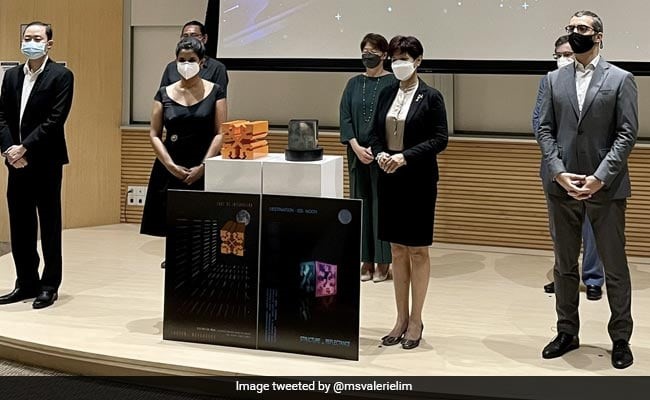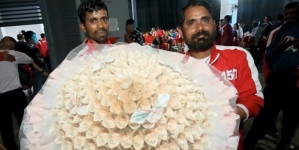-
LONDON: Indian-Origin Teen In UK Gets “Life-Changing” Cancer Treatment - 5 hours ago
-
SILICON VALLEY: All About Pavan Davuluri, New Head Of Microsoft Windows - 5 hours ago
-
LONDON: UK’s India Gate To Commemorate Role Of Indian Soldiers From World Wars - 1 day ago
-
HARARE: Shri Bramha Kumar appointed as the next Ambassador of India to the Republic of Zimbabwe - 2 days ago
-
LONDON: Indian-Origin Principal Wins UK Legal Challenge Over School Prayer Ban - 2 days ago
-
TORONTO: Indian-Origin Doctor Needs ₹ 2 Crore For Legal Fees. Elon Musk Responds - April 22, 2024
-
KINSHASA: India-Democratic Republic of Congo Foreign Office Consultations - April 21, 2024
-
LONDON: UK Court Allows Sale Of Nirav Modi’s Luxury London Apartment - April 21, 2024
-
TEHRAN: Travel advisory for Iran and Israel - April 20, 2024
-
LUXEMBOURG: Shri Saurabh Kumar concurrently accredited as the next Ambassador of India to the Grand Duchy of Luxembourg - April 20, 2024
SINGAPORE CITY: Indian-Origin Singapore Artist’s Works Are Orbiting Earth On Board ISS
SINGAPORE CITY: Two locally designed artworks by an Indian-origin artist in Singapore are now orbiting Earth aboard the International Space Station (ISS) as part of a 64-piece Moon Gallery collection of miniature works by international artists.
Kerala-born Lakshmi Mohanbabu, who moved from Delhi to Singapore in 2001 and is a naturalised Singaporean, has been working on the art project for the past two years in collaboration with the National Additive Manufacturing Innovation Cluster (Namic).
“I always felt that my artwork has a message for the world,” Ms Mohanbabu said.
The artworks reached the space station on Monday on a cargo craft, and will spend the next 10 months as part of a test flight for artists to learn how the different designs and materials perform in the microgravity of space.
The two artworks from Singapore are 3D-printed metal cubes featuring unique patterns, each side measuring 0.98cm, according to a report by The Straits Times. They were designed by Ms Mohanbabu, based on the concepts of unity, diversity and complexity in humankind.
The first cube, titled The Cube of Interaction, was prototyped in collaboration with Associate Professor Daniel New from the Singapore Centre for 3D Printing at Nanyang Technological University (NTU).
They created two iterations of the cube in different materials and identified the most suitable material. The final version was then manufactured by a local vendor via machining.
The second cube, named Structure & Reflectance, features four unique faces that were made by changing the crystal orientation of steel during the 3D printing process.
This is a proprietary technique developed by Assistant Professor Matteo Seita and his team from NTU’s School of Mechanical and Aerospace Engineering and the School of Materials Science and Engineering.
The project was supported by Namic, a national programme office that accelerates the adoption and commercialisation of additive manufacturing technologies.
Like the other artworks, the two cubes are encased in an 8-cm by 8-cm tray, each in a 1-cm by 1-cm cell where they can, depending on their size and design, float freely. “Each piece in this tiny gallery with a big mission explores the meaning of a shared human culture,” states an inscription on the Moon Gallery.
While it is hoped that the gallery will spark conversation and bring joy to the astronauts aboard the space station, its mission also has a scientific purpose, said the Moon Gallery Foundation, a non-profit organisation based in the Netherlands that promotes collaboration between the creative and space/technology sectors.
At a hybrid NTU event celebrating the successful launch of the Moon Gallery to the ISS on Monday, Second Minister for Finance and National Development Indranee Rajah said that Namic had supported over 240 initiatives in various industries like healthcare, marine offshore, aerospace and construction.
It will play a major role in the future of distributed manufacturing and digital trade.
“For example, 3D printing in emerging industries such as cellular agriculture and space technology can be a key enabler in strengthening Singapore’s position as a leading trade and manufacturing hub,” the media report quoted Indranee, who is also Minister in the Prime Minister’s Office, as saying.
Moon Gallery plans to send the first permanent extraterrestrial art gallery of 100 works of art, each no larger than a cubic centimetre, to the Moon by 2025.























